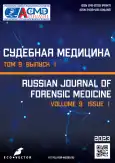Blind penetrating wound of the skull by a nail
- Authors: Mechukaev A.A.1,2, Sarakaeva A.Z.1
-
Affiliations:
- Bureau of Forensic Medical Examination
- Kabardino-Balkarian State University
- Issue: Vol 9, No 1 (2023)
- Pages: 79-85
- Section: Case reports
- URL: https://journals.rcsi.science/2411-8729/article/view/133087
- DOI: https://doi.org/10.17816/fm757
- ID: 133087
Cite item
Full Text
Abstract
When investigating various crimes, suicides, and accidents, the question of the capabilities of the human body to preserve vital functions in the presence of an injury may be important. Of particular difficulty is the issue whether a person could perform independent actions despite having a severe brain injury. Thus, the accumulation of practical expert and clinical observations characterizing the body’s capability to perform active targeted actions despite the presence of fatal wounds in various organs is of considerable practical interest.
This study described the morphological features of damage to head structures in a patient hit by a building fastener (a metal nail, 15 cm long) into the cranial cavity. The morphological changes in the anatomical structures along the wound channel had typical features: perforated fractures of the skull with a cone-shaped expanding defect of the inner walls of the perforated fracture. Brain structures were damaged along the wound channel. The stab wound was blind. The possibility of performing complex independent actions in the case of fatal brain damage is possible only with a comprehensive assessment of forensic medical examination data of the corpse and case materials.
Keywords
Full Text
##article.viewOnOriginalSite##About the authors
Alihan A. Mechukaev
Bureau of Forensic Medical Examination; Kabardino-Balkarian State University
Email: aliimech@mail.ru
ORCID iD: 0000-0001-6471-6532
SPIN-code: 9631-3040
MD, Cand. Sci. (Med.)
Russian Federation, Nalchik; NalchikAminat Z. Sarakaeva
Bureau of Forensic Medical Examination
Author for correspondence.
Email: sarakaeva2015@mail.ru
ORCID iD: 0000-0001-7249-401X
SPIN-code: 8549-3999
MD, Cand. Sci. (Med.)
Russian Federation, NalchikReferences
- Burmatov AP. On the question of the ability to perform directed active actions. Topical Issues Forensic Clin Med. 2008;(10):22–24. (In Russ).
- Grigoriev MV, Desyatov VP. On the ability to take active actions of a mortally wounded person. Forensic Med Examination. 1967;(3):50–51. (In Russ).
- Zagryadskaya AP, James-Levi DE. Forensic medical assessment of the ability to take active action in case of fatal mechanical damage: Methodological recommendations. Gorky: Gorky Medical Institute named after S.M. Kirov; 1978. 55 р. (In Russ).
- Solovyova IP. On the ability to take active actions in case of fatal brain injury. Questions Forensic Med. 1979;(2):80–83. (In Russ).
- Aggrawal A, Pradhan M, Sreenivas M. Nail injury to the brain obfuscated by a fall from height - homicide or suicide? A case report. Med Sci Law. 2015;55(1):40–43. doi: 10.1177/0025802414524191
- Chiarelli PA, Impastato K, Gruss J, Lee A. Traumatic skull and facial fractures. In: Ellenbogen RG, Sekhar LN, Kitchen ND, da Silva HB, eds. Principles of Neurological Surgery. 4th ed. Philadelphia, PA: Elsevier; 2018. Р. 445–474.
- Son S, Kang DH, Kim BH, Choi NC. Incidentally discovered a self-inflicted a nail in the brain of schizophrenia patient. Psychiatry Investig. 2011;8(3):272–274. doi: 10.4306/pi.2011.8.3.272
- Klevno VA, Hohlov VV. Forensic medicine: Textbook for universities. 2nd ed., revised and updated. Moscow: Yurait; 2022. 413 p. (In Russ).
- Kryukov VN. Basis of mechanogenesis and morphogenesis fractures. Moscow: Pholium; 1995. 232 p. (In Russ).
- Pigolkin UI, Dubrovin IA, Leonov SV, Gornostaev DV. Traumatic brain injury. Mechanogenesis, morphology and forensic medical evaluation. Moscow; 2018. 248 p. (In Russ).









